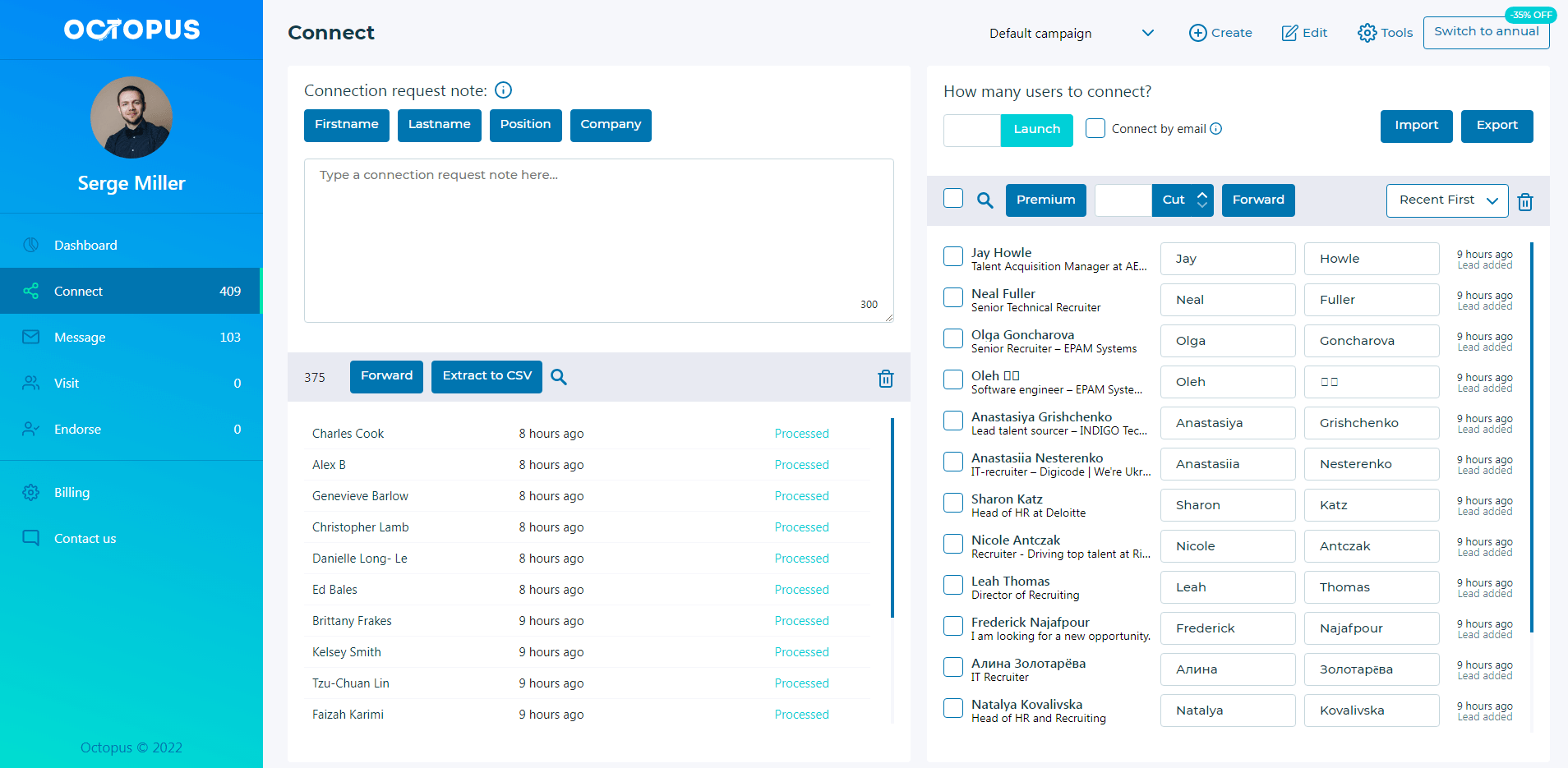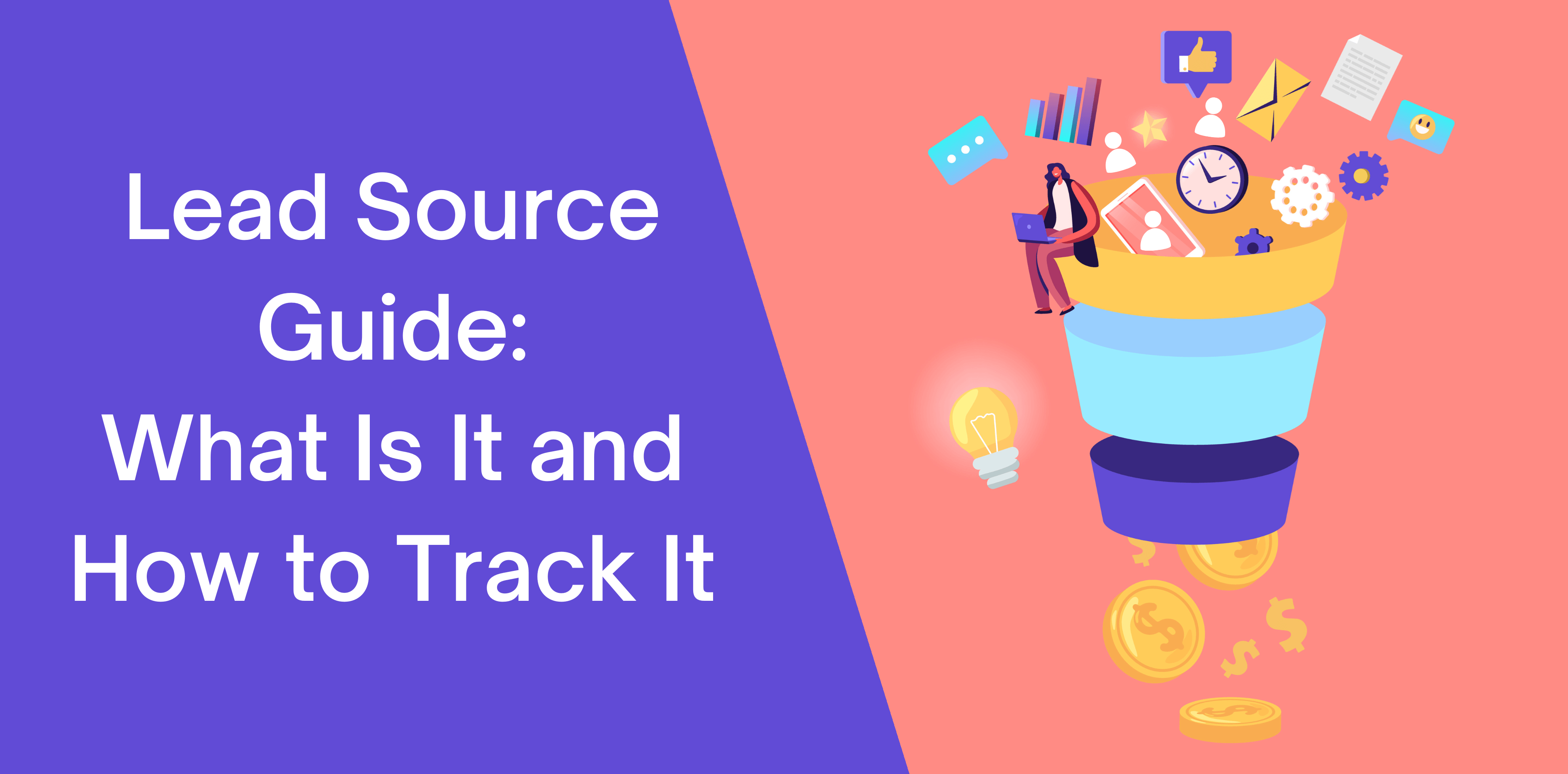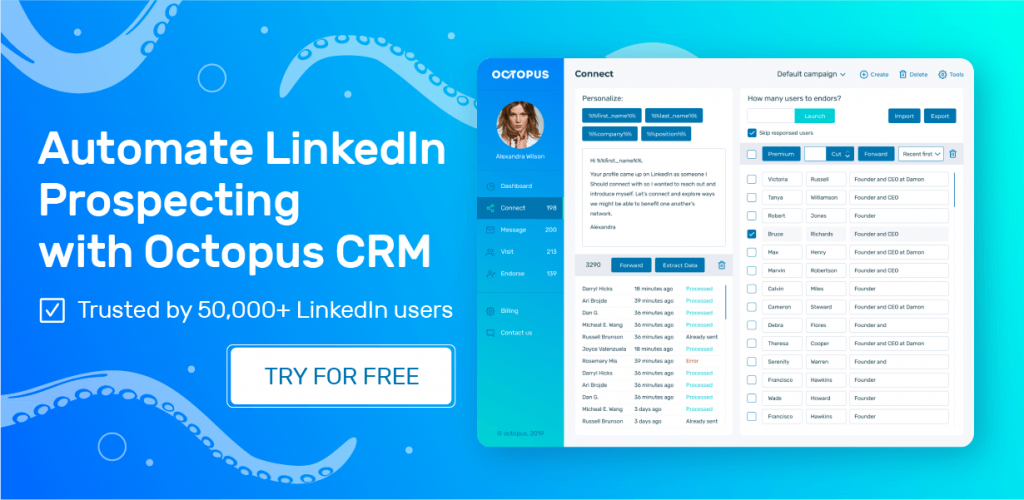The better you understand your buyer personas and prospects, the easier it is to target them effectively. It includes identifying the platforms they spend their time, learning their challenges and needs, and how they find your business.
If you’re unaware of how businesses trace and by which method a lead comes across your company, this is the article for you! Here we’ll discuss:
- Why you need to know the lead source
- Ways to capture lead source data
- How can you identify where a client comes from
- The best lead source examples
Let’s dive in!
What is a Lead Source?
A lead source indicates how a particular lead discovers your business and takes action. It could be through social media channels, a blog, or email newsletters.
For instance, a sales lead might learn about your company through a Facebook post, decide to search for your website, visit it, and is now highly likely to make a purchase.
Why Does a Lead Source Matter?

Understanding and identifying lead sources provide insightful context around why and how your prospects come across your company. As a result, you can enhance the customer experience and buyer’s journey.
Furthermore, it enables you to determine which lead sources are valuable to your business, allowing you to direct your attention to them. Let’s discuss the reasons lead sources matter in-depth:
Track where Your Leads Come From
Lead sources enable you to identify how a lead finds out about your company and enters your database.
Ideally, your lead will tell how your audience requests contact from your sales team, the selling points that get results, and the keywords that generate the most leads.
Moreover, it can help you identify which marketing efforts convert audience members into sales leads.
Identify Which Marketing Channels are Performing the Best
Every business uses eight marketing channels to interact, engage, and convert leads.
Although all marketing channels can help generate leads, their effectiveness in attracting qualified leads varies depending on your business type, product, and target market.
Identifying your lead sources can help you pinpoint the marketing channel that delivers the best leads, allowing you to capitalize on their potential and grow sales.
Shorten Your Sales Cycle Effectively
According to research, it takes the average sales rep 102 days to complete a sales cycle. Here too, your business type, ideal customer, and product influence the time required to close a deal.
Remember, your leads are talking with you and your competitors. So, speed is the name of the game. Your lead may jump to a competitor’s website if you take longer to reply.
But determining which lead sources guide qualified leads can help you shorten the sales cycle and increase your closing rate.
Check Your Marketing ROI
35% of marketers believe that understanding their ROI is “very important” or “extremely important.”
Measuring and managing your lead sources allows you to connect the dots on how different marketing channels contribute to your business’s bottom line.
Improve Your Sales and Marketing Strategies
When improving your marketing strategies and coming up with relevant content to capture your target audience, it’s crucial to ask the following questions:
- Which lead source marketing tactic performs the best?
- Where did most of your lead opportunities come from?
- Where are sales reps finding contacts?
With this data, you can make informed, data-driven decisions to reshape your marketing and sales strategies.
Types of Lead Sources
There are various types of lead sources. Here we discuss the most common ones:
Search Engines

Leads that come across your business through search results are precious, especially if they click through to your page.
Your click-through rate is a vital indicator of how well you attract and convert organic traffic.
Listing Websites
The right SEO tactics can drive traffic to your website listings on review sites. Therefore, if a website has more traffic, the more potential buyers you can attract.
Cold Calls
If a person calls your company out of the blue and inquires about a product or service, they’re a sales lead- a valuable one.
Since the cold caller is already somewhat engaged with your brand, it should be easy to warm up to the lead and move along the sales funnel.
Direct Mail
Despite the growth of digital marketing, businesses still regularly see direct mail.
Anyone who sends a letter or postcard in the mail advertising a product or service is trying to source leads through postal mail.
Cold Mails
Cold emails are another excellent way of sourcing leads. Creating a compelling and educational copy and integrating an inbound link can help generate qualified leads.
Paid Ads
PPC, social media targeting and display ads are fantastic ways of generating leads. Moreover, you can create targeted leads by running ads since you get seen by people who fit your target market.
Events
Hosting or receiving an invitation as a guest to a webinar, an event, or a sales podcast, whether virtual, in-person, or hybrid, can help grow brand awareness. Therefore, you get the opportunity to position yourself as a brand authority and create new connections.
As a result, you can draw qualified leads to your business and grow your sales.
Referrals

It’s no surprise that referrals are the easiest leads to land. Since these people visit your website by following a recommendation by a close friend, family, or trusted associate, they are warmer than other leads.
Therefore, you stand a better chance of converting these prospects into profit-generating buyers.
Related article: How to Ask for Referrals from Your Clients
Blogs
Blogs, particularly long-form posts, are a proven and fantastic way of directing traffic to your website.
According to research, 77% of people read blog posts on the internet, and 60% of buyers purchase after reading a blog about it.
Therefore, you might lose many qualified leads if you don’t have a content marketing strategy.
Guests Posts
Publishing guest posts to high-domain authority sites within your niche helps you expand your outreach and establish yourself as an authority. In turn, you can attract high-quality leads to your website.
But remember that writing guest posts that deliver quality leads requires time and dedication.
Landing Pages
Creating a captivating and informative landing page, whether your home page or product features page, can help make an excellent first impression. Doing this can motivate viewers to engage with your website and make contact.
Social Media

Social platforms, like Facebook, LinkedIn, Insta, and Twitter, are some of the best lead source types.
Using different social media channels improves brand awareness and builds brand trust by creating quality posts and videos.
Related article: How to Increase Website Traffic with LinkedIn
Micro-Influencers
Collaborating with micro-influencers helps you tap into a new consumer base to grow brand awareness. By talking about your brand and its offerings, these influencers redirect qualified traffic to your website.
Relationship Marketing
Relationship marketing entails developing deep connections with customers by providing excellent customer service.
With this time of marketing, you can focus on building customer loyalty by occasionally interacting with an email or a small purchase.
A bonus of relationship marketing is that it helps build brand ambassadors for future lead-generation efforts.
Traditional Advertisements
Contrary to popular belief, T.V. channels and radios are still viable lead sources. In fact, research reveals that 92% of U.S. adults listen to the radio, and 88% of watch T.V.
Therefore, if you’re not using traditional media, you fail to reach many potential customers.
Open Houses
Open houses aren’t exclusive to realtors.
Your business can hold an open house to teach the audience more about the company’s internal operations. It also encourages adults to bring their kids along, thus creating a long-lasting experience.
Competitors
Your competitors are also excellent lead sources, particularly if you partner with them. Or you can study their approach, audience, and leads to gather valuable data and implement it to drive more website traffic.
Voice Assistants
Voice assistants, such as Alexa and Siri, have revolutionized and simplified how people search for content.
One excellent feature these virtual assistants offer is that you can instruct them to execute various tasks by speaking to them.
Learning which voice assistant sends the most leads your way can help you optimize your content, thus increasing the number of qualified leads you receive.
P.R.
Public relations opportunities like press releases and media coverage can help you attract excellent leads. You can look into magazines, newsletters, and press conferences, and even make announcements to encourage people to create content about your brand.
Networking
Networking, whether online or offline, can help you generate qualified leads. You can warm up to your leads quickly and effectively with the right content and strategies.
Related article: How to Network on LinkedIn
Lead Source Examples
To help you have a better understanding of lead sources, we’ve added a few examples down below:
Example # 1:
Suppose you’re a sales rep aiming to meet your monthly quota by selling an innovative SaaS product. Your ideal buyer is an operation executive who needs your tool to streamline their workflow.
A message arrives in your LinkedIn inbox from a potential customer wanting to learn more about your product. So, what’s your lead source? LinkedIn!
Example # 2:
While cold calling, you speak to a current customer on the phone and ask for some referrals. Since 83% of customers are willing to offer one, they readily agree.
The following day, a lead calls you inquiring about a product you offer, meaning referrals are your lead source.
Example # 3:
Picture this: you’ve created a compelling and vivid video and just uploaded it on your social media. Several minutes later, a lead sends you a message asking you about the features and costs of the product.
Therefore, in this case, your lead source is social media.
How to Track Lead Source?
Tracking and measuring your lead sources is critical to improving your lead generation strategy. Learn how to identify and track lead sources by following the steps below:
Seat Goals

Having goals can help you identify which of your lead sources perform well. You don’t want to invest additional time and effort in a lead source that doesn’t produce results.
Therefore, by setting goals, you can determine whether your efforts are successful.
Utilize the Right Tools
You need tools around if you want to track a lead source. It won’t be practical to track your lead source figures manually. You can get data analysis, reports, and lead generation analytics that assist you in learning more about each lead source when your products are functioning for you.
Go Granular
Although listing a lead source as “social media” is an excellent place to start, it isn’t always sufficient information. With multiple social media platforms available, you want to know whether your lead originated on Facebook or Instagram. Get specific; retain “social media” as the main category but add subcategories for each social media campaign you launch.
Track CTAs
Calls to action (CTAs) are essential for generating leads. Therefore, you should track each CTA if conducting numerous lead-generation campaigns. By adding UTM parameters to your CTA URLs, you may achieve this. You’ll be able to determine which of your CTAs generates the most leads in this manner.
Check Your Results

A lead source that consistently produces high conversion rates may suddenly or gradually stop doing so. Make sure you track your lead sources when you check them quarterly to see how well they are converting. Conversion rates and lead sources work together to provide valuable insights about how to adapt your lead generation initiatives to continue attracting clients.
Try New Channels
Find out which channels you are currently absent from once you have listed all of your lead sources. You can locate other lead sources that can provide new leads for your company by exploring different locations. It enables you to reach out to new audiences and determine whether a lead source you haven’t tried before is helpful for your company.
Why Do I Need to Track Lead Sources?
A lead source is crucial to view the results and comprehending the scope of your digital marketing activities. Your duty as a marketer is to use digital marketing strategies to attract fresh leads and customers. Your lead generation initiatives should aim to expose a lead source to as many audience members as possible.
You can gauge your lead sources’ effectiveness by identifying and monitoring them. It allows you to change your tactics as needed to maximize your efforts and achieve your lead-generating objectives. You can detect this and take a step back to adjust your techniques, for instance, if your email marketing isn’t generating the desired amount of leads.
It also enables you to maximize your ROI. Make sure you get a return on your investment with your digital marketing techniques if you invest time, money, and effort in them. You run the risk of losing money more quickly than you are generating new leads if you don’t monitor the performance of your lead sources.
Choose the most effective marketing methods
A business connects with, engages, and converts lead through an average of eight channels. While all marketing channels can produce leads, their success in generating the correct leads for your company greatly depends on your business’s nature (B2B or B2C), offering, and target market.
You may identify the lead sources that are producing qualified leads that your sales team can close rapidly and take advantage of them by measuring your lead sources.
Shorten your sales cycle

Did you know that a sales rep needs roughly 102 days to finish a sales cycle? Again, the time it takes for your sales staff to close a qualified lead will depend on your business, product, and customer profile.
In the end, 50% of your leads will not be a suitable fit for your offering, according to HubSpot. When calculating lead scores in your CRM, you can factor in which lead sources are producing qualified leads. Your sales team may do so now that hot leads are ready to buy and are easier to find. Therefore, you will have a shorter sales cycle and more deals closed by your sales representatives.
Prove your marketing ROI
According to 39% of marketers, this is the main issue. By measuring your lead sources, your marketing team can see how these channels affect your company’s bottom line.
Improve Your Sales Process
There are several ways to improve sales lead management, but one of the most important is to review the lead nurturing process.
Any business can generate leads, but very few companies have a nurturing process to take those leads to the point of conversion. About 65% of B2B organizations, according to MarketingSherpa, have never set up lead nurturing.
In terms of lost income, it amounts to millions of dollars, primarily when cultivated leads result in a 20% increase in sales compared to uncultivated leads.
Lead nurturing can help you produce more leads and turn more prospects into the clients you need to expand. Follow these instructions to complete and enhance your sales lead management and start noticing a significant increase in your lead-to-close ratio.
Extensive Research
Improving any lead management strategy requires you to recognize and comprehend your leads. You must identify your potential customers and your ideal client before you can take any further action. It will form your lead management strategy.
You will short yourself if you don’t use all of your teams. Your marketing and sales teams should come together at this time to work together and share information. Marketing may be very insightful about different buyer types and audience segments, creating personas to represent the ideal client.
Create a Content Plan

You may shape the sales funnel, and the route you want leads to follow before they convert using the knowledge you gain about the buyer’s journey from research.
Once you have a funnel, you may start aligning content with the buyer’s journey. The structure for your lead nurturing process is as follows, and the kind of content you produce will depend on where the lead is in the funnel.
Case studies and research/white papers help to promote your solution further in the funnel when a lead is more interested in your answer. Task marketing to work with sales to develop the appropriate content your sales team needs to assist lead nurturing.
Improve Sales with Lead Scoring
A solid scoring system can raise the quality of leads your sales team receives by considering a variety of variables, from demographics to behavior, as potential criteria for deciding the lead’s score. If you decrease the number of poor leads, your sales team will have more time to deal with the leads that are most likely to convert.
Positive and negative lead scoring standards will differ widely from business to business. Based on your company model and the characteristics of your ideal consumer, you must determine those requirements.
Passing on the Leads
At this point, losing a significant amount of potential income is easy. Even with a CRM in place, it is possible to miss leads. Automated or approval processes can ensure that you do not overlook leads and only proceed when meeting specific requirements. Make the process of passing leads to sales a strategic one.
What are the Benefits of Lead Source Reporting?
Understanding Lead Source in Salesforce improves the performance of your sales and marketing pipelines and enables you to utilize the platform to its fullest potential. Here are three explanations:
Tracks Where Leads Originate
A lead source is a method by which a lead learns about your company and joins your marketing database. Leads originate from different sources. When you correctly record lead source data, regardless of whether you have offline lead sources or/and online advertising ones, your Salesforce game improves.
You can learn how your audience members found your business using accurate lead source data, which gives you essential insights.
A complete lead source data set should, ideally, comprise these five features:
- How is your audience asking to get in touch with your sales staff
- The selling aspects that result in success
- The precise keywords that are generating the most leads
- The marketing avenues that successfully reach your target market
- The marketing initiatives that help in converting a customer into a sales lead.
Improves Sales Funnel

Today, a sales funnel resembles more of a highway, so it’s best to avoid thinking about it linearly when studying it. Leads don’t convert linearly. Therefore it’s crucial to track their origins by keeping track of their sources.
Prospects can walk back and forth in the funnel, skip steps, and enter it from different points. Or they take an extended period taking just one step. That does not imply they won’t ever purchase your goods or services.
Consumers are more aware than ever, so a longer sales cycle may occasionally be the best option. You may effectively get to know your leads better and close deals by concentrating on providing pertinent information to educate your leads and establishing trust.
Improves Marketing Strategies

The answer to saving time on monotonous and unnecessary tasks is sales automation. However, the time saved should be used by concentrating on lead nurturing initiatives.
Based on the information from your Lead Source, it might be helpful to brainstorm as a marketing team the following questions when restructuring the marketing mix and creating more pertinent content to give to your target audience:
- Which marketing strategy is most effective?
- Where do most of your closed wins originate?
- How did you get your accounts?
- How do Sales Development Representatives locate contacts?
In contrast, the sales team can gain from using Lead Source because it enables them to warm up older leads, filter and categorize sales leads, and automate more lead nurturing processes.
It is essential to comprehend lead sources to demonstrate your usefulness as a marketing or sales representative. However, getting lost in the b2b marketing reporting world is simple, with many data sources and channels to examine.
Without prioritizing and fixing data quality concerns first, effective reporting is impossible.
A built-in Salesforce solution that finds problems with data quality and provides customized remedies automatically so you can:
- Make your reporting simpler and demonstrate your worth.
- Always be aware of the source of a lead.
- Create a buying group to tailor the purchasing
Lead Source Best Practices
You must invest in lead source tracking to maximize the effectiveness of your B2B lead generation channels.
Many businesses use free, open-source lead management programs that work well with CRMS. Here are three examples:
MoData
MoData is a solution for accelerating revenue and doing sales analytics. It has tools for pipeline reporting and leads source monitoring.
To ensure that your team’s data is consistent and based on a single source of truth, integrate this tool with your HubSpot CRM and compare your lead sources with your sales representatives. View, send, and easily share pre-built reports and easily alter pipeline dashboards.
Salesforce
Salesforce, a top CRM, allows you the option to track lead sources, view your leads in numerous drag-and-drop pipelines, and analyze them, in addition to connecting any application that would make your job easier.
CallRail
CallRail is a platform for call tracking and marketing analytics that provides lead attribution by source reporting. In every phase of the buyer’s journey, this feature employs multi-touch attribution to give you reports for every CallRail lead source and interaction type that matters to your team. You may filter and compare unqualified leads to qualified leads.
Conclusion
A lead source is how potential customers learn about your company, goods, and services. If you don’t know the origin of your leads, you can’t manage your lead generation efforts accurately.
You can optimize your entire digital marketing process, from making a new contact to converting them into a customer, by taking the time to track and identify your lead sources.

